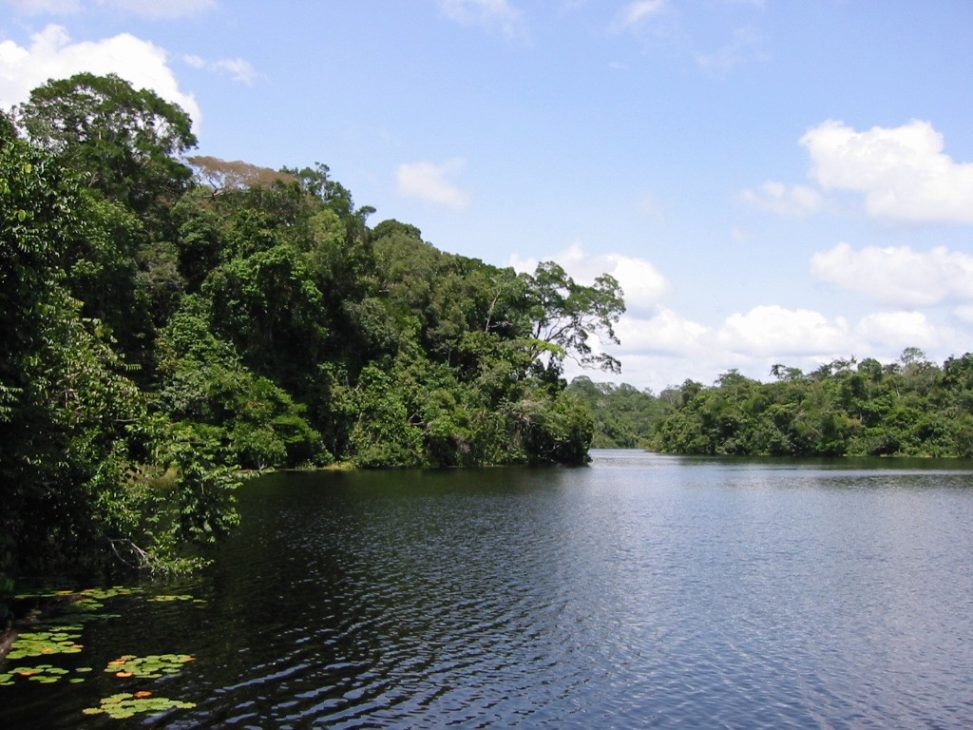The lungs of the world
The Amazon rainforest, which mostly lies in Brazil, is hugely important for the planet and its sustainability. The rainforest contains an incredible diversity of plants and wildlife, is a source of medicine and food and is home to many indigenous populations. The Amazon is also a major store of carbon and an important source of moisture, influencing rainfall as far away as the western USA.
The Amazon is sometimes called the planet’s lungs, as it absorbs carbon dioxide, a greenhouse gas, as well as producing 20% of the world’s oxygen, through photosynthesis. This occurs in the estimated 390 billion trees in the region, which absorb carbon dioxide and store it in their leaves, branches and trunks.
The growth of the Amazon rainforest can naturally offset the build-up of carbon dioxide in the atmosphere from fossil fuel emissions. If the rate of tree growth increases this additional absorption of carbon dioxide helps to limit climate change. However if the Amazon’s forests are cleared or damaged, the region loses carbon which accelerates climate change. In fact, the Amazon is under long-term and ongoing threat from deforestation. Climate change itself can also have a direct impact, for example by reducing tree growth through extreme weather. We need to understand the complex interactions of climate and land use change with the ecology of the Amazon. This understanding will help to improve climate predictions by the UK Met Office, and will guide Brazilian policy makers towards priorities for rainforest conservation.
Building science partnerships
To help address these challenges the Climate Science for Service Partnership (CSSP) Brazil project, funded by the UK Government’s Newton Fund, is bringing together researchers and organisations from the UK and Brazil and building long-lasting science partnerships. The University of Edinburgh is one of the UK partners in CSSP Brazil and our work is contributing to the response to the challenges outlined above. Other UK partners in the project include the Universities of Exeter, Bristol, Leeds and Reading as well as the National Centre for Atmospheric Science. CSSP Brazil is also building strong, sustainable partnerships with Brazil’s National Institute for Space Research (INPE), National Institute for Amazon Research (INPA) and the National Centre for Monitoring and Early Warning of Natural Disasters (CEMADEN).
Addressing the challenge
Whilst we know the Amazon is a huge store of carbon, the exact quantity and the amount it exchanges with the atmosphere each year is a question of scientific debate complicated by the fact that the rainforest covers over 6 million square kilometres. Having a more precise measure of these stores and exchanges will help us to understand the impact human stressors such as deforestation and climate change are having on the Amazon. Researchers have typically used direct observations in the forest to measure C exchanges. These are now supplemented by satellite observations across the region, which provide a less detailed, but extensive knowledge base. Earth system models (computer models that represent the complex interaction of the atmosphere and forests) are then used to predict how these exchanges and carbon stores will change in the future.Currently, there are large differences between observation (direct and satellite) estimates of Amazon carbon exchanges and stores and those predicted by models. These differences lead to scientific uncertainty of the Amazon’s response to deforestation and climate change, which hinders necessary climate mitigation and adaptation actions.
Identifying and implementing improvements
Here at the University of Edinburgh, a research group led by Mat Williams, is developing a toolkit which will allow Brazilian and UK partners to easily compare their models to the latest sets of observations. This toolkit compares stores and exchanges of carbon in the Amazon and across Brazil, looking at annual cycles over the past decade. The comparison enables the strengths and weaknesses of individual models to be evaluated and shared between the Brazilian and UK science communities. The University of Edinburgh are hosting Brazilian researchers to provide training and support to use the toolkit. Together we are collaborating to identify and implement improvements in the way their models represent the Amazon rainforest. This, in turn, will support improved predictions of how the Amazon will respond to climate change and deforestation.
Informing climate mitigation and adaptation policy
This new evidence could help inform policies which support climate change mitigation and adaptation in Brazil. For example, it could help inform and support Brazil’s commitment to the United Nations Framework Convention on Climate Change (UNFCCC) Paris Agreement, whereby countries aim to keep long-term global temperature to “well-below 2°C”. Under the same convention Brazil are required to accurately report their greenhouse gas emissions to the United Nations and this new toolkit will support that activity.
This work is also well aligned to support the United Nations Sustainable Development Goals which represent a global commitment to transform the world to a sustainable and resilient path to development, focussing on areas of critical importance for humanity and the planet. CSSP Brazil is directly supporting the Climate Action (13), Life on Land (15) and Partnerships for the Goals (17) goals.
Next steps
We will continue this work with a focus on other ecosystems across Brazil such as the flooded forests of the Amazon, which cover over 1 million square kilometres, and the cerrado savannas south of the Amazon. Our goal is to enable climate models to effectively represent the storage and cycling of carbon in these systems. This will improve our understanding of these ecosystems and how they might respond to climate change and deforestation, which will help support their sustainable management.
UK Funding Support
The Newton Fund builds research and innovation partnerships with 17 active partner countries to support their economic development and social welfare, and to develop their research and innovation capacity for long-term sustainable growth. It has a total UK Government investment of £735 million up until 2021, with matched resources from the partner countries.
The Newton Fund is managed by the UK Department for Business, Energy and Industrial Strategy (BEIS), and delivered through seven UK delivery partners, which includes UK Research and Innovation (comprising the seven research councils and Innovate UK), the UK Academies, the British Council and the Met Office.
by Professor Mathew Williams
Chair of Global Change Ecology, University of Edinburgh
For further information visit the Newton Fund website (www.newtonfund.ac.uk) and follow via Twitter: @NewtonFund
CSSP Brazil is a research project that supports scientific collaboration between the UK and Brazil. For more information on the project, and the individual work areas, please visit https://www.metoffice.gov.uk/research/collaboration/newton/cssp-brazil




Leave a Reply